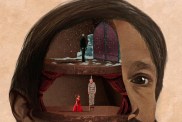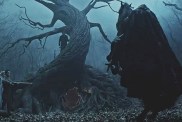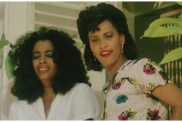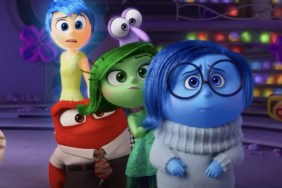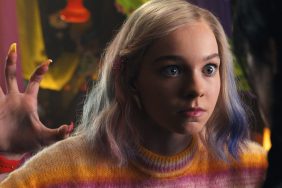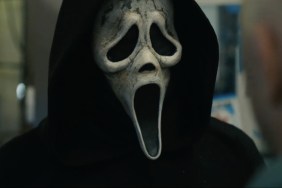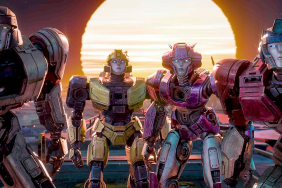
The Good Dinosaur story plays as a western survival tale, starring a boy and his dog
What if the dinosaurs never died out? That little idea was where The Good Dinosaur story all began. Unlike the wholly separate reality of Disney•Pixar’s Cars franchise, the world of the film was designed to serve as an alternate reality to our own. Imagining that a catastrophic asteroid missed the Earth millions of years ago, The Good Dinosaur story flashes forward to a somewhat more evolved group of dinosaurs who have an awful lot in common with frontier settlers. In fact, The Good Dinosaur story ultimately plays out as a western survival tale starring a boy and his dog.
“Only in our story,” says director Pete Sohn, “the boy is a dinosaur and the dog is a boy.”
Related: Meet The Good Dinosaur Characters!
ComingSoon.net had the opportunity to visit Pixar Animation Studios in Emeryville, California last week to meet a few of the talented artists that have been working for years to bring The Good Dinosaur story to life. Sohn — who directed the Pixar short “Partly Cloudy” — is also well known for providing a number of memorable voices over the years. He played Emile in Ratatouille and Squishy in Monsters University. Matching The Good Dinosaur’s western theme, Sohn joined producer Denise Ream for a campfire slideshow in Pixar’s recently-constructed Brooklyn building.
“From the moment Arlo is born, he’s afraid of the world,” Sohn continues. “He’s fun-loving and determined; he’s got a lot of fire when it comes to his desire to help his family. But he’s scared. His fear holds him back.”
Arlo comes from a family of apatosaurus farmers, but doesn’t feel like he quite fits in. His brother and sister, Libby and Buck, are bigger than him and Arlo feels like a constant disappointment.

“Poppa gives Arlo a job — a mission to earn his mark,” Sohn explains. “Arlo is tasked with catching a critter. A pest who’s eating the food they’ve stored for the winter. At last, Arlo has a chance to prove his worth. But in the end, he can’t do it. He can’t kill this creature he’s captured, and he sets it free, much to his father’s disappointment.”
Things get really bad, though, when a disastrous series of events leads to Arlo getting swept downstream of a massive river. Knocked unconscious, Arlo wakes up, bruised and weary, sometime later. Terrified, he knows only to follow the river across some very rough terrain.
To get the full experience of a mighty river, The Good Dinosaur crew took a “field trip” to the Snake River in Wyoming. What the team found there would influence The Good Dinosaur story on a multitude of levels.
“One of the things that Pete talked about was how he really wanted the environment to be another character in the film,” set supervisor David Munier tells us. “And to be the adversary for Arlo on his journey. There’s not as much dialogue in this story, so he needed the environment to help tell the story in a certain way.”
The outdoor environment for The Good Dinosaur may appear photo real, but it’s actually a finely-targeted blend of technical detail and aesthetic design, inspired by the American Northwest. In addition to material gathered from the Wyoming trip, Munier and his team made use of the US Geological Survey to accurate capture bits of mountainous terrain. Other parts of the scenery actually used Google Earth, inspired by satellite images from Idaho’s Salmon River.

Incredibly, the lighting on The Good Dinosaur is largely “practical” with, for the first time, 3D volumetric clouds being used to diffuse light.
“These storm clouds are almost like a villain in the film,” explains director of photography-lighting Sharon Calahan. “…These particular clouds can be rendered and we can light them, which we’ve never been able to properly do before. They’re beautiful.”
One of the reasons the scenery is so important to The Good Dinosaur story is because the enormous Arlo needs to look dwarfed by the massive terrain he must travel. First, though, the Pixar team needs to make sure exactly how Arlo travels in the first place.
“One of the most intimidating things to animate is a quadruped,” says animator Rob Thompson, “because there’s so much to them and there’s so much to manage. It’s very easy to make it not work if you don’t know what you’re managing.”
To figure out Arlo’s walk, Kevin and fellow animator Kevin O’Hara went to a local zoo to shoot video of elephants in motion.
“Locomotion is all about efficiency,” Thompson continues. “A lot of times you think, ‘We’re animating a big, heavy character. We should slam those feet. That’ll make it feel heavy.’ The truth is, that’s not efficient. That wouldn’t be great for the legs.”
Drawing right on top of the video itself, the animators broke Arlo’s basic walk down into four distinct parts. That was then taught to the entire team who, as they worked on their specific segments, were encouraged to build on the basics, adding reality where they saw fit.

While the animators are looking at character movement, the production design team is developing the various characters. One room at Pixar is covered in bright, colorful images of all the relevant designs.
“The director looks at this room as, really, a design element in itself,” says production designer Harley Jessup. “You can feel the progress that the team has made during the week and we’re addressing notes the director has given. I like to think that, as he walks in the door, he can think, ‘Yeah, this feels better.’”
Jessup himself took a lot of inspiration from westerns, listing David Von Ancken’s Seraphim Falls and Michael Cimino’s Heaven’s Gate as two visual influences on The Good Dinosaur.
Some of the people that the crew met on their Wyoming trip shaped The Good Dinosaur’s characters as well. When a lost GoPro washed downstream, one of the “mountain man” guide was able to, a short time later, fish it out a ways downstream just by “reading the river.” That connection with nature itself played a big part in creating Butch, a Tyrannosaurus Rex voiced by Sam Elliot.
“[Pete] wanted them to be cowboys,” says O’Hara of the film’s T. Rex family. “He wanted them to be Sam Elliot on horseback.”

That’s just one of the pieces of The Good Dinosaur story that had its origins in story development.
“Our primary job is to take Meg [LaFauve]’s well-written words and translate them into the video medium,” says story supervisor Kelsey Mann. “So we draw the movie.”
Story development takes The Good Dinosaur script and breaks it down into roughly 30 story pieces. Then, Mann “casts” the right artists for the right scenes and puts groups to work, trying to figure out the very best move visually for each scene. Everyone then meets up in the story room to brainstorm or present their ideas.
“What we’re supposed to do is get to true feelings in here,” Mann continues. “We want the films to be open and honest about the way we experience life as human beings.”
“As a writer, it’s an incredible experience to realize what works on the page does not work,” says screenwriter Meg LaFauve. “Or to realize, ‘Oh my god. That works better than we ever thought!”
There’s a lot more still to be uncovered about The Good Dinosaur, so check back with ComingSoon.net for more information in the not too distant future, including a full interview with Sohn himself.
What do you think of The Good Dinosaur story now that there are getting to be more details? Let us know in the comments below!
The Good Dinosaur
-
The Good Dinosaur

-
The Good Dinosaur

-
The Good Dinosaur

-
The Good Dinosaur

-
The Good Dinosaur

-
The Good Dinosaur

-
The Good Dinosaur

-
The Good Dinosaur

-
The Good Dinosaur

-
The Good Dinosaur

-
The Good Dinosaur

-
The Good Dinosaur

-
The Good Dinosaur

-
The Good Dinosaur

-
The Good Dinosaur

-
The Good Dinosaur

-
The Good Dinosaur

-
The Good Dinosaur

-
The Good Dinosaur

-
The Good Dinosaur

-
The Good Dinosaur

-
The Good Dinosaur

